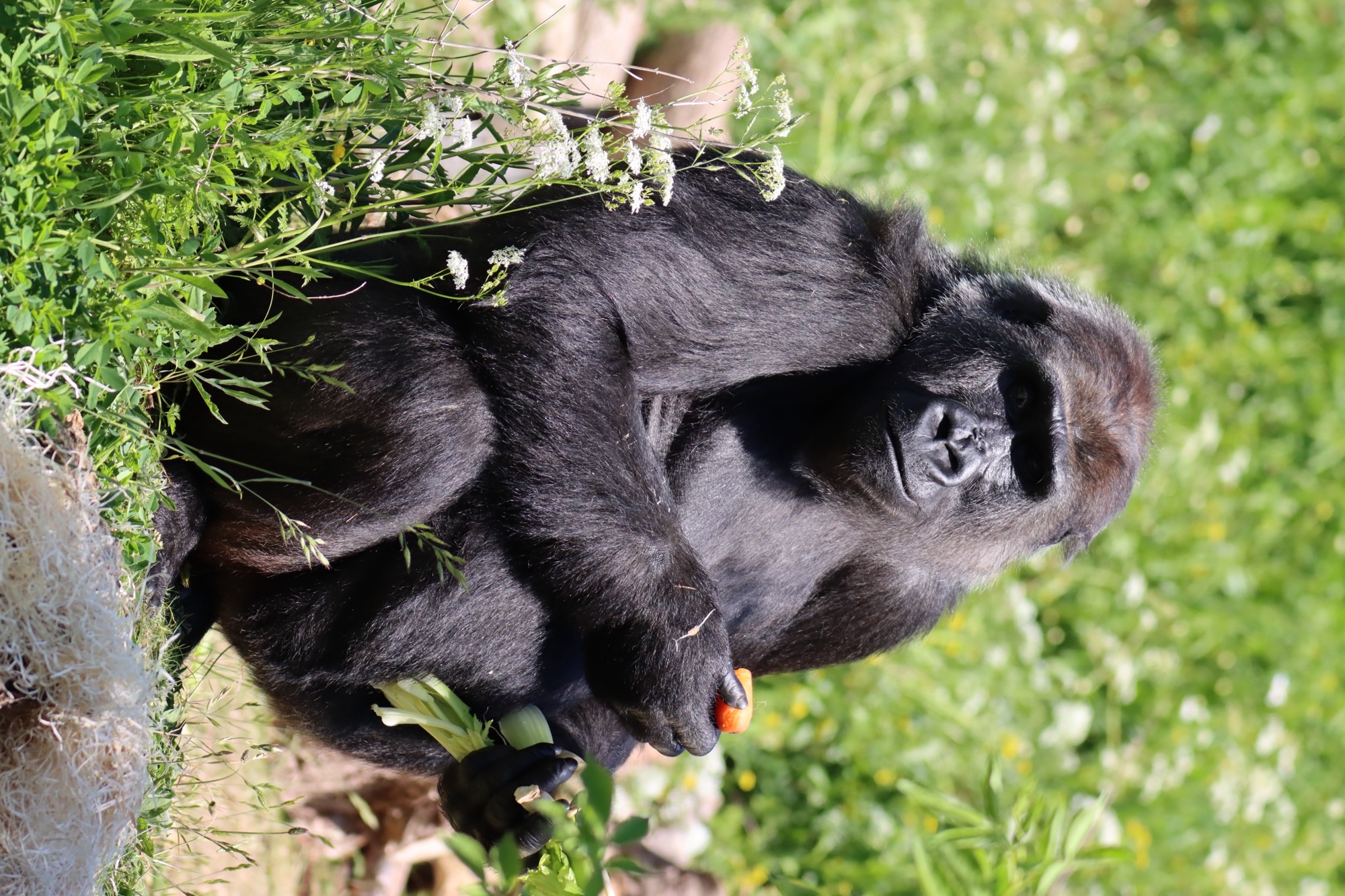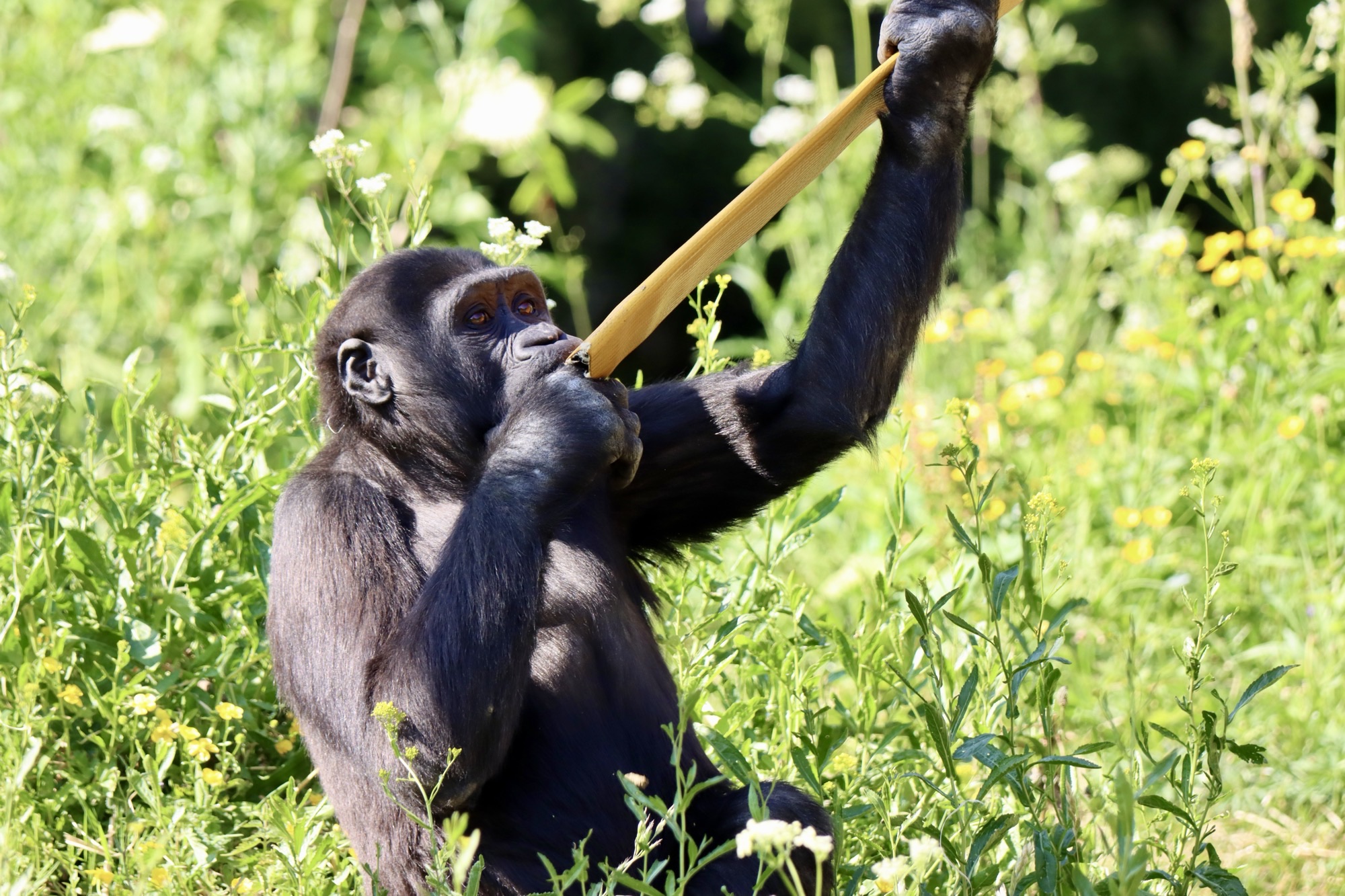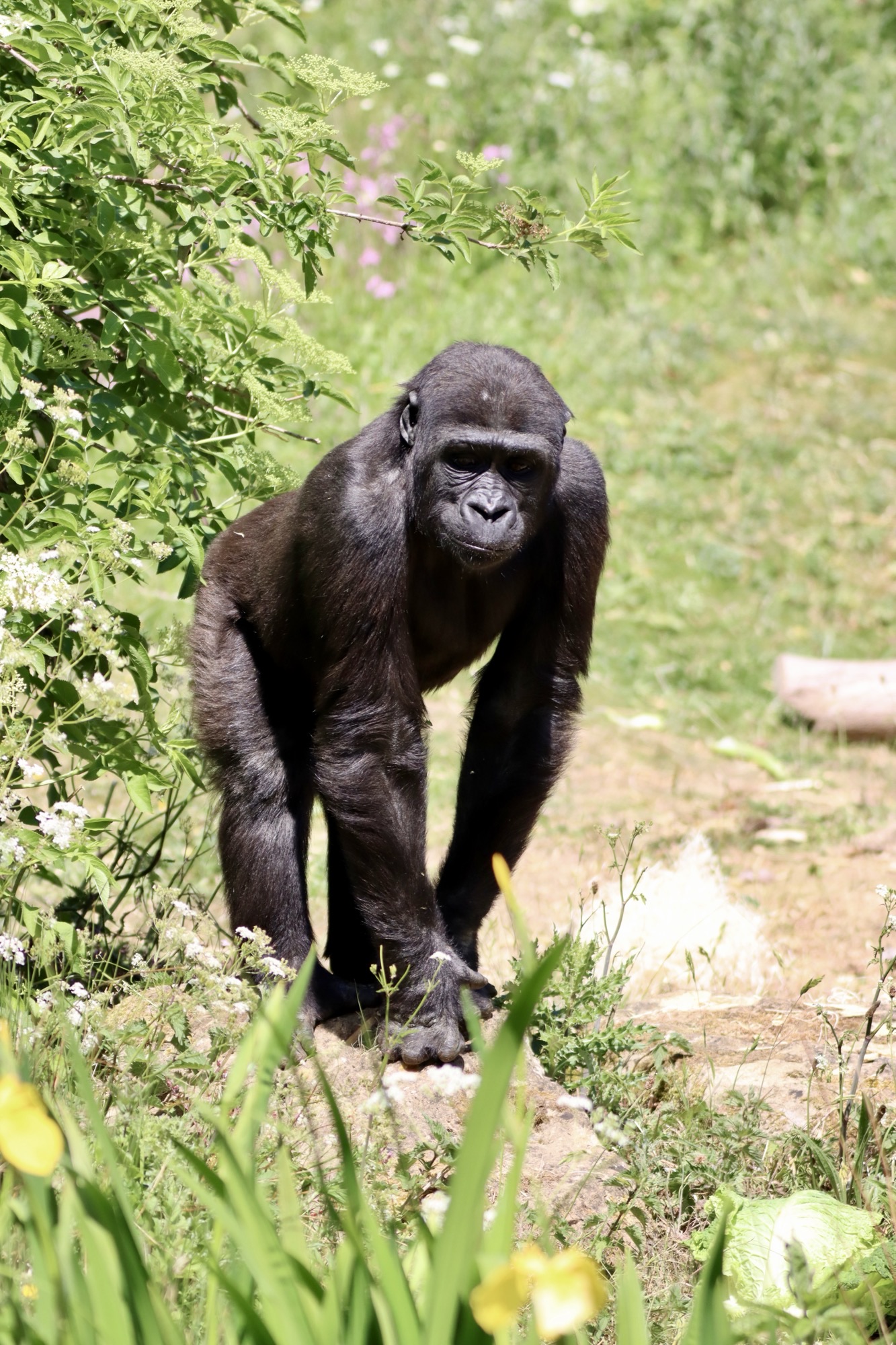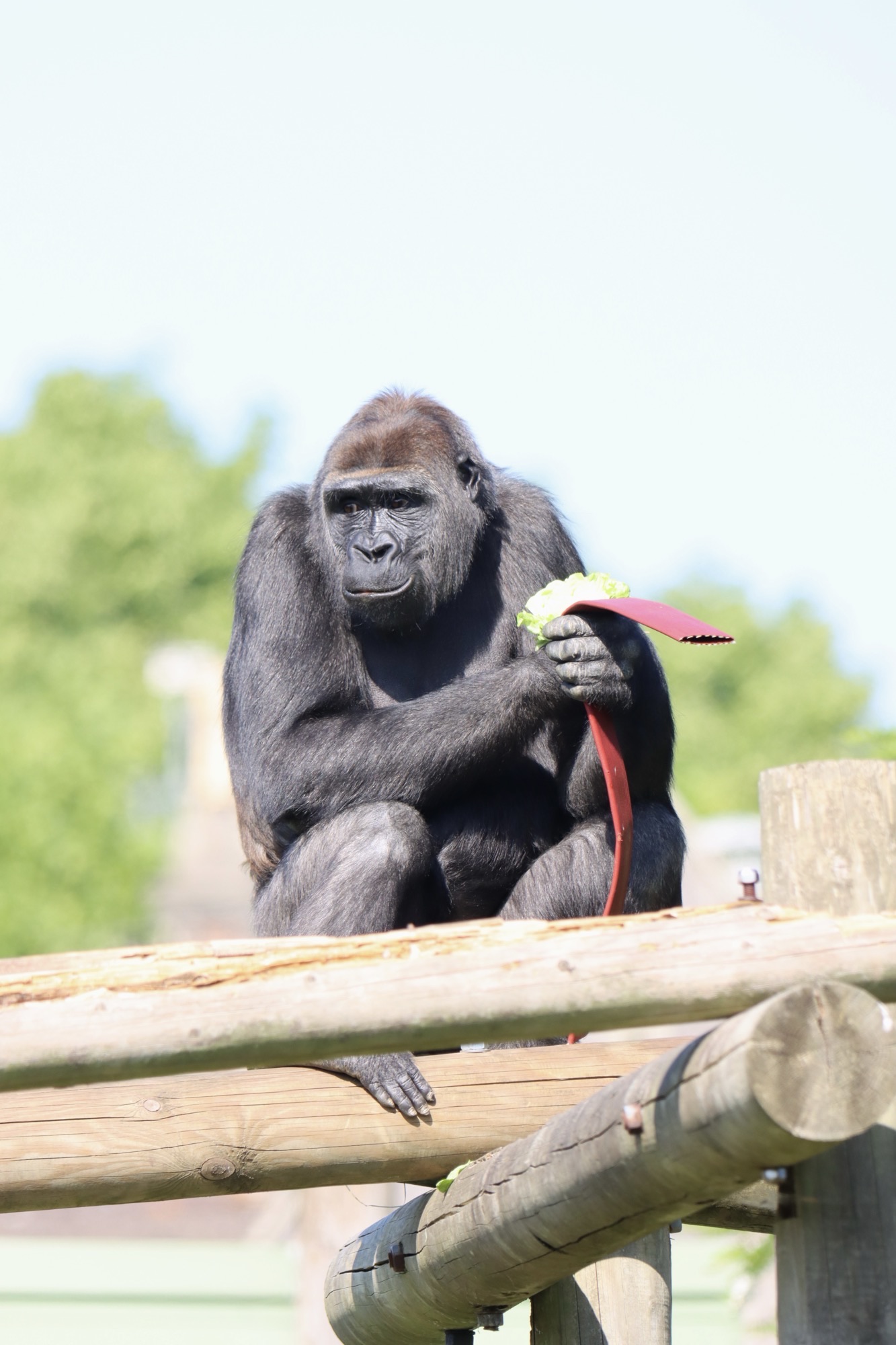
7 fascinating facts about gorillas
Posted on: 2 July, 2025
Gentle giants that hold the title of the largest primate in the world, gorillas share nearly 98% of our human DNA.
There are four subspecies of gorilla; western lowland, cross river, eastern lowland and mountain. Here at Bristol Zoological Society, we care for western lowland gorillas, the third largest of the subspecies, but they are still known for their large size, powerful strength, and fascinating social behaviours.
They are the most widespread gorilla subspecies and have unique physical characteristics. Western lowland gorillas are critically endangered, and it’s believed that only around 300,000 remain in the wild. Discover some fascinating facts and find out more about how we care for our gorillas.
 1. Gorillas are vegetarian
1. Gorillas are vegetarian
Gorillas are herbivores, which means they stick to a mainly vegetarian diet, eating a whole range of plants including stems, leaves, and fruits. As we mentioned in our previous blog, What we Feed our Gorillas at Bristol Zoo, our gorilla troop eat just over 50kg of vegetables a day, with one-fifth of this being consumed by the troop’s silverback, Jock.
Gorillas spend a significant portion of their day foraging, which enables them to consume a wide variety of plants, using their agile lips, hand dexterity and strength to manipulate and break apart the parts of the plants they like to consume the most. Unlike other apes, gorillas’ digestive tracts are more similar to the other herbivores we have at Bristol Zoo Project, including giraffe and zebra, with their longer tracts making them hind gut fermenters, which allows them to digest lots of fibrous plants and fruits.
2. Gorillas can live into their 60s!
The lifespan of gorillas is estimated to be around 35 years in the wild, with their biggest threats being large predators such as leopards and crocodiles, as well as human impact from poaching, disease transmission, and habitat loss. Gorillas living in zoos can live up to 50 years old, and the oldest reported gorilla, Fatu, currently lives in Berlin Zoo in Germany, where she celebrated her 68th birthday in April this year. In June 2025, our magnificent silverback Jock celebrated his 42nd birthday!
 3. Gorillas exhibit a range of behaviours and emotions similar to humans
3. Gorillas exhibit a range of behaviours and emotions similar to humans
In our previous blog, The Fascinating Behaviour of our Gorilla Troop, we shared some wonderful insights into the behaviours of our family group of western lowland gorillas, including physical posturing, vocal communication and facial expressions.
Just like humans, every gorilla is unique and they all have their own characteristics, behaviours and ways of communicating. They live within complex social hierarchies, but value friendships both within their family units and with other gorillas they encounter. Like humans, gorillas express themselves through a range of emotions, vocalising through laughing, rumbling, coughing, grunts, whimpers, roars and screams. They are also highly intelligent and use a range of tools to forage and play, embracing all of the different enrichment activities we provide for them at Bristol Zoo.
Gorillas also love to play! Infants, adolescents, and even adults enjoy and learn through play, just like us!
 4. Gorillas like to dress up
4. Gorillas like to dress up
Gorillas also like to express themselves by occasionally ‘dressing up’, generally using foliage or their bedding. Most frequently seen in the juveniles and females, common accessories include the ever-popular ‘stick hat’, ‘straw scarf’ and ‘bedding veil’.
5. Gorillas really invest in their young
A gorilla’s gestation period is around the same time as a human’s; they are pregnant for 8.5 months (257 days) and typically give birth to one baby at a time. Gorillas really invest in their young and will only tend to give birth every four to six years! Like us, gorilla infants are born very vulnerable and are not weaned before four years of age.
At Bristol Zoo, Hasani has recently stopped breastfeeding, which is a major step on his way to becoming a grown-up gorilla. Juni is still breastfeeding, but mum Touni is trying her best to wean him. Gorilla mothers and infants have a close and dependent relationship, especially in the first few months. They sleep in the nest with the mother at night and ride on her back during the day, clinging to her for comfort and protection.
The silverback, or dominant male, also plays a vital role in the raising of young, protecting them from potential threats, as well as shielding them from aggression in the group. Our infant boys, Juni and Hasani, are close to silverback Jock, often copying his behaviours in charging motions and wrestling, feeling safe enough to invite play with him, as well as tease him by stealing his favourite foods.
 6. Gorillas, particularly males, have a cone-shaped head
6. Gorillas, particularly males, have a cone-shaped head
The skull of a gorilla is one of the most distinct features, with a cone-shaped appearance that supports their powerful jaw muscles. The sagittal crest is a ridge of bone that runs down the centre of the top of the skull and meets the nuchal crest, a bony shelf located at the back of the skull, and both act as attachment points for these strong jaw muscles. These are not for anything fierce like fighting but are necessary for their diet, enabling them to chew vegetation and grind down food. Female gorillas also have these crests, but they are not as prominent.
7. Gorillas have a unique nose print
Similar to human fingerprints, gorillas have unique nose prints that allow for individual identification. Their nose prints come in different shapes and sizes, with unique patterns of wrinkles that can help researchers identify them in the wild. From the intricacies of the folds to the ridges, bumps and pleats, no nose is the same, and this has been crucial to the research of gorillas in the wild.
 As well as caring for our family troop here in Bristol, we also collaborate with in-country partners in Monte Alén National Park, Equatorial Guinea, on several projects aimed at protecting the species. This includes monitoring their presence in the national park through camera traps, as well as creating a crop-foraging deterrent strategy, and working with local communities to help promote more positive human-wildlife coexistence.
As well as caring for our family troop here in Bristol, we also collaborate with in-country partners in Monte Alén National Park, Equatorial Guinea, on several projects aimed at protecting the species. This includes monitoring their presence in the national park through camera traps, as well as creating a crop-foraging deterrent strategy, and working with local communities to help promote more positive human-wildlife coexistence.
At Bristol Zoo Project, we’re currently building a new African Forest habitat, which will be home to our troop of Critically Endangered western lowland gorillas, as well as other threatened species African Forest has been designed to closely reflect their natural habitat, including a natural forest canopy that reflects the dense forests of Equatorial Guinea.
 We are raising the vital funds needed to support the creation of African Forest, the new home for our gorilla troop and other key endangered African species, You can find out more about the appeal, donation rewards and the African Forest development here.
We are raising the vital funds needed to support the creation of African Forest, the new home for our gorilla troop and other key endangered African species, You can find out more about the appeal, donation rewards and the African Forest development here.

